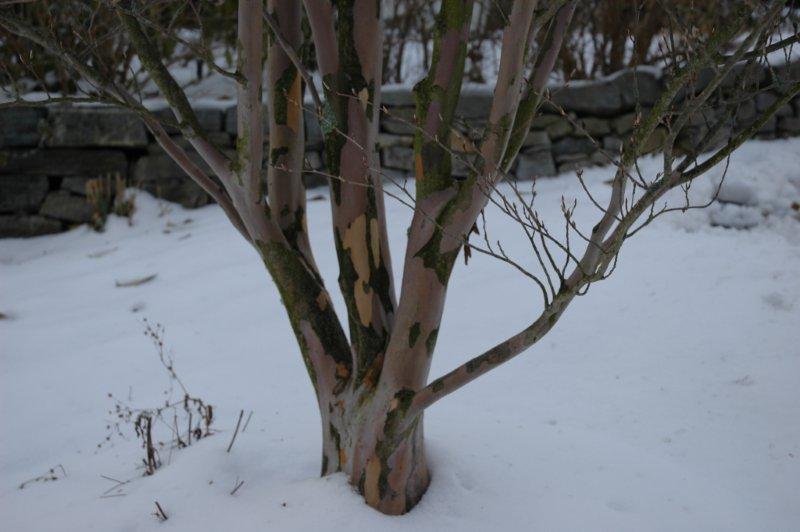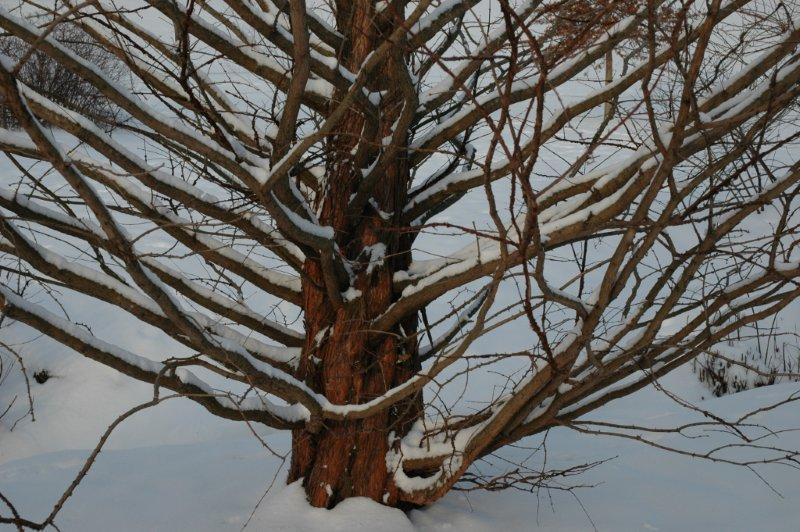by Kathy Diemer
Please also visit Kathy’s blog: www.agardenforall.com
When hunting for a deciduous tree that will look smashing year 'round and not give you a lick of trouble, here are a few of my favorite decadently barked zone 5 hardies to consider:
 Japanese Stewartia (Stewartia pseudocamellia): I'll never understand why all the garden magazines rave over the spring flowers of this tree, when there is so much more to talk about. I mean, what is all the fuss about some white camellia looking blooms that only last the briefest amount of time and don't even smell delicious? Yes, the flowers are attractive, but what I would shout from the mountaintops is that this small tree is a dazzling, fire engine red in the fall, and the winter display is one of the most intriguing collaborations of color; tan, mauve, grey, copper, all sporadically mixed throughout its trunk. In zones 5-8 with some late day shade, this gem will slowly grow well over 20'.
Japanese Stewartia (Stewartia pseudocamellia): I'll never understand why all the garden magazines rave over the spring flowers of this tree, when there is so much more to talk about. I mean, what is all the fuss about some white camellia looking blooms that only last the briefest amount of time and don't even smell delicious? Yes, the flowers are attractive, but what I would shout from the mountaintops is that this small tree is a dazzling, fire engine red in the fall, and the winter display is one of the most intriguing collaborations of color; tan, mauve, grey, copper, all sporadically mixed throughout its trunk. In zones 5-8 with some late day shade, this gem will slowly grow well over 20'.
 Dawn Redwood (Metasequoia glyptostroboides): This is a tree to consider if you have a moist area and the room to accommodate a large tree; in your lifetime it will easily grow 30' or more. At maturity, dawn redwood can grow over 100' tall by 20' wide in zones 5-8. Considered a living fossil, metasequoia was once one of the most widespread tree species in the Northern hemisphere during the Tertiary period. The attributes I love about Metasequoia glyptostroboides are its unusual rippled mahogany trunk and peeling bark, especially attractive in winter, the upright form and unusual branching habit, which provide a comfortable perch for birds, and the soft deciduous needles that turn gold in the fall before dropping. As it matures, the roots come up from the ground like prehistoric serpents swimming around the base. It is hard to find a good specimen, so take the time to find one with a conical, well branched form and you will be rewarded amply for your efforts.
Dawn Redwood (Metasequoia glyptostroboides): This is a tree to consider if you have a moist area and the room to accommodate a large tree; in your lifetime it will easily grow 30' or more. At maturity, dawn redwood can grow over 100' tall by 20' wide in zones 5-8. Considered a living fossil, metasequoia was once one of the most widespread tree species in the Northern hemisphere during the Tertiary period. The attributes I love about Metasequoia glyptostroboides are its unusual rippled mahogany trunk and peeling bark, especially attractive in winter, the upright form and unusual branching habit, which provide a comfortable perch for birds, and the soft deciduous needles that turn gold in the fall before dropping. As it matures, the roots come up from the ground like prehistoric serpents swimming around the base. It is hard to find a good specimen, so take the time to find one with a conical, well branched form and you will be rewarded amply for your efforts.
 River Birch (Betula nigra): A recent introduction to my garden; I quickly fell head over heels for the river birch. While other start struck lovers are dreaming of their beloved, (or perhaps a box of chocolates), I'm besotted with a tree. But not just any tree can sweep me off my feet, enchanting me with its ravishing exterior...Betula nigra, an Eastern U.S. native in zones 4-9, subtly compliments any landscape from spring through fall, but ignites the winter scene with captivating ornamental scrolls of bronze gently peeling from the trunk. Preferring moist soil, but tolerant of poor conditions, river birch is a fast grower even in the driest seasons (In my garden it tripled its size in three years, even during months of severe drought).
River Birch (Betula nigra): A recent introduction to my garden; I quickly fell head over heels for the river birch. While other start struck lovers are dreaming of their beloved, (or perhaps a box of chocolates), I'm besotted with a tree. But not just any tree can sweep me off my feet, enchanting me with its ravishing exterior...Betula nigra, an Eastern U.S. native in zones 4-9, subtly compliments any landscape from spring through fall, but ignites the winter scene with captivating ornamental scrolls of bronze gently peeling from the trunk. Preferring moist soil, but tolerant of poor conditions, river birch is a fast grower even in the driest seasons (In my garden it tripled its size in three years, even during months of severe drought).
 Paperbark Maple (Acer griseum): Unlike the traditional sugar maples, paperbark has a smaller stature (slow growing to 20-30') and unusual three fingered leaflets that resemble poison ivy foliage. Similar to its cousins, Acer griseum produces a blaze of fall color in the richest shades of crimson that linger late into the season. However, it is the splendor of paperbark's exfoliating trunk that captures my attention. The array of peeling layers in shades of silver, rust, cocoa and khaki, curl and flake from its stems in the most enticing way. This irresistible tree will grow in zones 5-8, preferring sun, but tolerant of some shade, and requires soil that will not completely dry out.
Paperbark Maple (Acer griseum): Unlike the traditional sugar maples, paperbark has a smaller stature (slow growing to 20-30') and unusual three fingered leaflets that resemble poison ivy foliage. Similar to its cousins, Acer griseum produces a blaze of fall color in the richest shades of crimson that linger late into the season. However, it is the splendor of paperbark's exfoliating trunk that captures my attention. The array of peeling layers in shades of silver, rust, cocoa and khaki, curl and flake from its stems in the most enticing way. This irresistible tree will grow in zones 5-8, preferring sun, but tolerant of some shade, and requires soil that will not completely dry out.
 American Sycamore(Platanus occidentalis): The towering sycamores that grow along the riverside roads near my home have always been my favorite native tree. For as long as I can remember, the size and grandeur of Platanus occidentalis mesmerized me. With its grey marbleized trunk and open, far reaching alabaster limbs contrasting against the blue fall sky, one can't help but be in awe of this gentle giant. That said, you need a lot of room (sycamore can grow over 150'), a sunny site and moist soil (zones 4-9) to provide this Appaloosa of trees with the optimal growing conditions. Because our native sycamore is prone to life threatening diseases (anthracnose and scorch), you may choose the smaller alternative; London planetree (Platanus acerifolia ‘Bloodgood’, the disease resistant cultivar), which is also a fast grower (only up to 80'), more tolerant of dry or clay soils, and has attractive flaking bark as well.
American Sycamore(Platanus occidentalis): The towering sycamores that grow along the riverside roads near my home have always been my favorite native tree. For as long as I can remember, the size and grandeur of Platanus occidentalis mesmerized me. With its grey marbleized trunk and open, far reaching alabaster limbs contrasting against the blue fall sky, one can't help but be in awe of this gentle giant. That said, you need a lot of room (sycamore can grow over 150'), a sunny site and moist soil (zones 4-9) to provide this Appaloosa of trees with the optimal growing conditions. Because our native sycamore is prone to life threatening diseases (anthracnose and scorch), you may choose the smaller alternative; London planetree (Platanus acerifolia ‘Bloodgood’, the disease resistant cultivar), which is also a fast grower (only up to 80'), more tolerant of dry or clay soils, and has attractive flaking bark as well.
 Email:
MadGardener@MadGardeners.org
Email:
MadGardener@MadGardeners.org
 Mailing Address: PO Box 146, Sherman, CT 06784-0146
Mailing Address: PO Box 146, Sherman, CT 06784-0146
Copyright © 2020 Mad Gardeners. All rights reserved.